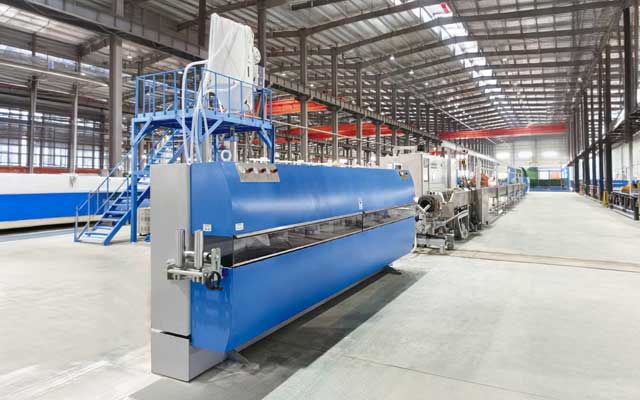Model 70-120Screw Diameter φ70-120L/D Ratio 26:1/25:1Extrusion Output 140-450 kg/hMain Motor 40-165 KWOutlet Diameter 2-80 mmSpeed 80-300Application YJV22 armored power cable
YJV22 Armored Power Cable Extrusion Line
YJV22 Cable Full Name: Copper Core XLPE Insulated Steel Tape Armored PVC Sheathed Power Cable. It is a very common type of armored cable in power systems, renowned for its excellent mechanical protection capabilities.
Letter Meanings:YJ: Represents the cable's insulation material, which is cross-linked polyethylene (XLPE).
V: Represents the cable's inner/outer sheath material, which is polyvinyl chloride (PVC).
2: Represents steel tape armor. This is the core difference between it and ordinary YJV cables.
2: Represents the polyvinyl chloride outer sheath (PVC), which wraps around the armor layer to prevent corrosion.
(Simplified understanding: The first digit "2" indicates the armor layer is steel tape, and the second digit "2" indicates the outer sheath is PVC).
Operating Temperature:Long-term allowable operating temperature: ≤90°C (same as YJV).
Short-circuit temperature (max. 5s duration): ≤250°C.
Main Features:Core Advantages:
Strong Mechanical Protection: The internal double steel tape armor layer provides the cable with extremely high resistance to compression, impact, and rodent bites.
Suitable for Direct Burial: Due to its exceptional pressure resistance, YJV22 cable is the preferred model for direct burial installation, eliminating the need for additional protective conduits, thus saving costs and time.
Excellent Performance: Inherits all the electrical advantages of YJV cables, such as high current-carrying capacity and good heat resistance.
Disadvantages:
Heavy Weight and High Rigidity: The steel tape armor layer significantly increases the cable's weight and bending difficulty, requiring more manpower during installation and a larger minimum bending radius (typically ≥ 15-20 times the cable's outer diameter).
Contains Halogens: The PVC sheath produces black smoke and toxic gases when burned.
Higher Cost: More expensive than non-armored YJV cables.
YJV22 Armored Power Cable Extrusion Line
The YJV22 low-voltage armored power cable extrusion production line is a complete set of equipment specifically designed for manufacturing insulated cores and protective sheaths of power cables rated at 0.6/1 kV and below. Its core process involves melting solid plastics (such as PVC or XLPE) through heating and pressurization, then continuously and uniformly coating conductors (copper/aluminum wires) or assembled cable cores. After cooling and solidification, a smooth, dense, and uniformly thick insulating layer or protective sheath is formed.
Core Components
The YJV22 armored power cable extrusion production line is a highly coordinated automated system, primarily consisting of the following major components:
Pay-off Unit:Supports and releases the conductor or cable core, providing stable and controllable tension to prevent thinning or twisting of the conductor.
Preheater:Heats the conductor before it enters the die head to remove moisture, reduce internal stress, and improve adhesion between the plastic and the conductor.
Extruder:Screw: Conveys, compacts, melts, and homogenizes the plastic.
Barrel: Heats and cools the plastic.
Drive Motor: Provides power to the screw.
Die Head: Connects the extruder to the die.
Die (Tip and Die): Determines the thickness, concentricity, and shape of the extruded layer.
Cooling Trough:Rapidly cools and solidifies the high-temperature cable. Typically features segmented temperature control to ensure material stability and avoid internal stress.
Haul-off Unit:Provides the driving force for the production line. Its speed must be extremely stable, as it is critical for ensuring uniform extrusion thickness.
Spark Tester:An online quality inspection device that applies high voltage to the insulating layer to detect defects such as pinholes or impurities, triggering alarms and marking the locations.
Take-up Unit:Winds the finished cable neatly onto a reel, maintaining constant tension and synchronizing with the haul-off speed.
Control System:Uses a PLC / industrial computer to centrally control all parameters (temperature, speed, tension, etc.), ensuring stable and reproducible production.
YJV22 Armored Power Cable Extrusion Line Datasheet
| Model |
70 |
80 |
90 |
100 |
120 |
| Screw Diameter (mm) |
φ70 |
φ80 |
φ90 |
φ100 |
φ120 |
| Screw L/D Ratio |
26:1 |
26:1 |
26:1 |
25:1 |
25:1 |
| Extrusion Amount (kg/hr) |
140 |
200 |
250 |
320 |
450 |
| Outlet Wire (mm) |
2-15 |
3-25 |
5-35 |
8-60 |
10-80 |
| Total Power (KW) |
40 |
55 |
63 |
120 |
165 |
| Production Speed(Max., m/min) |
300 |
200 |
200 |
100 |
80 |
| Take-up Spool |
500/800 |
800/1250 |
800/1600 |
1000/2000 |
2000/2500 |
| Storage Length |
240 m |
200 m |
180 m |
0 |
0 |
YJV22 Armored Power Cable Extrusion Line Application
The YJV22 low-voltage armored power cable extrusion production line is a complete set of equipment specifically designed for producing YJV22 armored cables & other insulation cores and sheaths of power cables with rated voltage of 0.6/1kV and below. The details are as follows:
Conductor Insulation
Function: Extrudes insulating material onto copper or aluminum conductors to form the primary insulation layer.
Common Materials: Cross-linked polyethylene (XLPE), polyethylene (PE), polyvinyl chloride (PVC), etc.
Requirements: Uniform thickness, high concentricity, absence of impurities, and no microvoids. The insulation extrusion process for high-voltage cables demands the highest technical precision.
Sheathing Extrusion
Function: Extrudes a protective sheath over the assembled cable core.
Purpose: Provides mechanical protection, corrosion resistance, moisture resistance, UV resistance, flame retardancy, etc.
Common Materials: Polyvinyl chloride (PVC), polyethylene (PE), polyolefins, etc.


